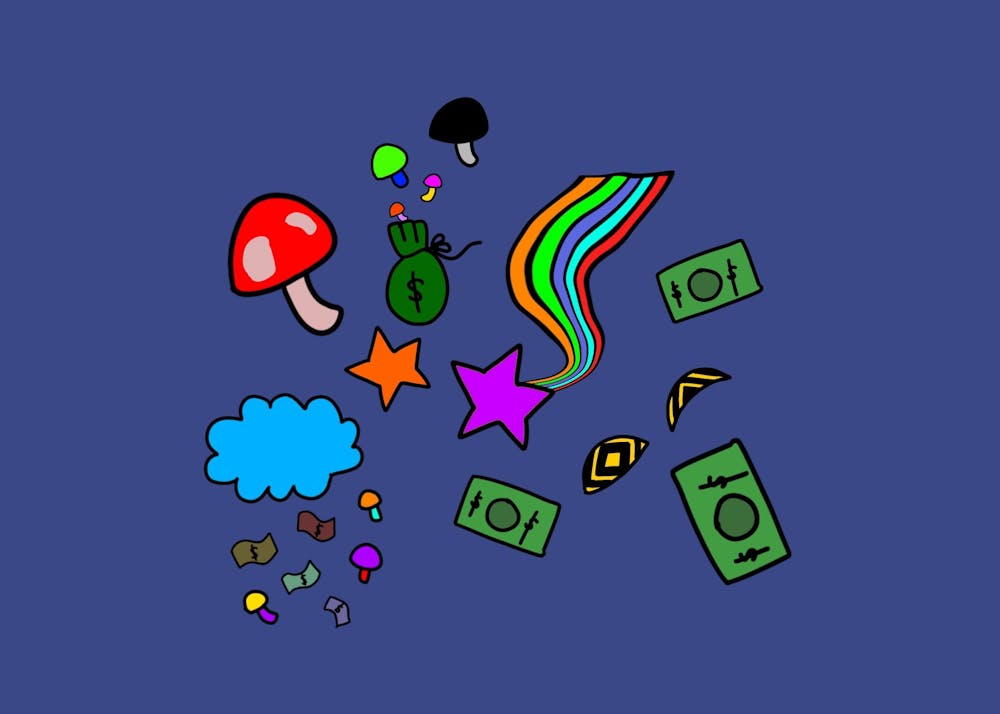Hopkins Medicine has been given a grant by the National Institutes of Health (NIH) to study the potential medicinal properties of psychedelics; specifically, the impact of psilocybin on tobacco addiction.
Participants will be assigned to either the treatment or control group. Treatment groups will receive several psilocybin sessions in addition to cognitive behavioral therapy to see if it impacts their ability to quit smoking.
In collaboration with the University of Alabama at Birmingham and New York University (NYU), Matthew Johnson, the Susan Hill Ward endowed professor of psychedelics and consciousness in the Department of Psychiatry and Behavioral Sciences, will lead the double-blinded study, meaning neither the participant nor researcher knows the treatment provided. He works with Peter Hendricks, a professor at the University of Alabama at Birmingham School of Public Health, and Dr. Michael Bogenschutz, the director of NYU Langone Center for Psychedelic Medicine.
Hopkins has been involved in the field of psychedelic research for a long time. In 2000, it became the first institution in the U.S. to receive regulatory approval to research the effects of psychedelics on those with no previous experience. In 2019, Hopkins announced the formation of the Center for Psychedelic and Consciousness Research, the first major psychedelic research center in the United States.
In an interview with The News-Letter, Johnson talked of the grant’s importance.
“The real excitement is that this is the first treatment research with a classic psychedelic compound in a half-century since the funding of LSD research going back to the 1960s,” he said. “It’s a big deal because it's been 20 years since the modern renaissance of psychedelic research, but it’s been the funding side of the government that’s been the last to the party.”
The grant was propelled by a 2014 pilot study done by Johnson and his research team that used a combination of cognitive behavioral therapy and sessions of increasingly larger doses of psilocybin that, together, led to an 80% rate of abstinence in smoking cessation after six months. The effect doesn’t seem to be centered on a specific biological mechanism.
In a 2014 interview, Johnson expounded the benefits of psychedelics that can’t necessarily be described with just quantitative science.
“Psilocybin can lead to deep reflection about one’s life and spark motivation to change,” Johnson said.
Johnson elaborated on this cognitive aspect of the study to The News-Letter. He explained how, unlike other clinical drug trials that carry risks of abuse, the cognitive behavioral approach that his team uses avoids that issue by ensuring that all psychedelic sessions take place with a researcher and medical professional.
“It’s not like this is a mechanistic study in rats or a study looking into researching the harmful effects of psilocybin on people. It’s a study where the treatment model doesn’t require the subject to go home with the [psilocybin],” Johnson said. “No one has to take a pill every day.”
Together, Johnson and his team will attempt to tease out the potential benefits for a class of drugs (psychedelics) that have long been thought to be dangerous and addictive, associated with so-called hippie culture and the war on drugs.
Johnson reflected upon the stigma associated with psychedelics, explaining how the passage of time has allowed for the easing of attitudes regarding their usage. Despite the weakening stigma, Johnson explains how there exists a kind of hypocrisy with psychedelic regulation, especially when presented with the wide array of drugs that are approved for clinical use by the Food and Drug Administration (FDA) and yet have all sorts of potential for abuse and misuses; amphetamines and opioids are clear examples.
Johnson elaborated on this apparent inconsistency.
“Psychedelics are the only major class of abused drugs that don’t have some accepted use defined by the FDA. So it really isn’t astonishing at all that this particular class of abused drugs happen to have some therapeutic potential when it was appropriately utilized in a way such that you address the potential risks,” Johnson said.
The grant is funded by the NIH, the largest public funder of biomedical research in the world, whereas the majority of psychedelic research for the past 50 years has been through philanthropic means. Johnson believes that the issue of public funding concerns the mindsets of federal lawmakers, referencing Marinol, a notable legal cannabis derivative.
“It's not a state vs. federal issue like you see with cannabis. It’s more akin to the legalization of Marinol back in 1985 because we’re dealing with an entity within a capsule with the exact known amount of the active ingredient,” Johnson said.
Like cannabis, psychedelics have been entering the mainstream media, with proponents including people and corporations alike arguing in droves for legalization and commercialization. Apart from being a professor at Hopkins, Johnson is also a clinical advisor for Mind Medicine, one of the aforementioned corporations and America’s first public psychedelic pharmaceutical company.
Johnson would go on to illuminate the potential of the psychedelic industry, explaining how rather than skirting government agencies and regulations like the cannabis industry, psychedelic corporations will be seeking direct FDA approval, lending it credibility and a particular potency for commercialization.
“There is a huge commercial future [for psychedelics], measured in billions of dollars,” Johnson said. “In fact, we are going to need companies to disseminate this [information] through the public, if the results hold up.”





